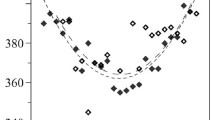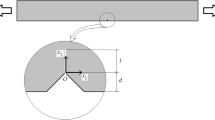Abstract
This work addresses the events involved in the fracture of tool steels, aiming to understand the effect of primary carbides, inclusions, and the metallic matrix on their effective fracture toughness and strength. Microstructurally different steels were investigated. It is found that cracks nucleate on carbides or inclusions at stress values lower than the fracture resistance. It is experimentally evidenced that such cracks exhibit an increasing growth resistance as they progressively extend, i.e., R-curve behavior. Ingot cast steels present a rising R-curve, which implies that the effective toughness developed by small cracks is lower than that determined with long artificial cracks. On the other hand, cracks grow steadily in the powder metallurgy tool steel, yielding as a result a flat R-curve. Accordingly, effective toughness for this material is mostly independent of the crack size. Thus, differences in fracture toughness values measured using short and long cracks must be considered when assessing fracture resistance of tool steels, especially when tool performance is controlled by short cracks. Hence, material selection for tools or development of new steel grades should take into consideration R-curve concepts, in order to avoid unexpected tool failures or to optimize microstructural design of tool steels, respectively.














Similar content being viewed by others
References
S.A. Horton and H.C. Child: Met. Technol., 1983, vol. 10, pp. 245-56
H. Berns and C. Broeckmann: Eng. Frac. Mec., 1997, vol. 58, pp. 311-25
T. Antretter and F.D. Fischer: Mater. Sci. Eng. A, 1997, vol. 237A, pp. 6-11
H. Berns, A. Melander, D. Weichert, N. Asnafi, C. Broeckmann and A. Groβ-Weege: Comput. Mater. Sci., 1998, vol. 11, pp. 166-80
F.G. Rammerstorfer, A.F. Plankensteiner, A.D. Fischer and T. Antretter: Mater. Sci. Eng. A, 1999, vol. 259A, pp. 73-84
J.D. Bolton and A.J. Gant: J. Mater. Sci., 1998, vol. 33, pp. 939-53
M.A. Gomes, A.S. Wronski and C.S. Wrigth: Int. J. Fract., 1997, vol. 83, pp. 207-21
S-H. Choo, C. Kyu, K. Euh, S. Lee, J.-Y- Jung and S. Ahn: Metall. Mater. Trans. A, 2000, vol. 31A, pp. 3041-52
F. Meurling, A. Melander, M. Tiedesten and L. Westin: Int. J. Fatigue, 2001, vol. 23, pp. 215-24
K. Shiozawa, L. Lu and S. Ishihara: Fatigue Fract. Engng. Mater. Struct., 2002, vol. 24, pp. 781-90
C.R. Sohar, A. Betzwar-Kotas, C. Gierl, B. Weiss and H. Danninger: Int J. Fatigue, 2008, vol. 30, pp. 1137-49
D. Das, R. Sarkarb, A. K. Duttac and K. K. Rayd: Mat. Sci. Eng. A, 2010, vol. 528A, pp. 589-603
I. Picas I, R. Hernández, D. Casellas, B. Casas, I. Valls, in Mechanical performance of cold forming tools, in Proc. 8th Int. Tooling Conf., P. Beiss, C. Broeckman, S. Francke and B. Keysselitz eds., Aachen, Germany; 2009, pp. 1037–48
T. Fett and D.Munz: J. Mater. Sci., 1993, vol. 28, pp. 742–52
D. Casellas, J, Alcalá, L. Llanes, and M. Anglada: J. Mat. Sci., 2001, vol. 36, pp. 3011–25
D. Munz: J. Am. Ceram. Soc., 2007, vol. 90, pp. 1–15
J. J. Kruzic, R. L. Satet, M. J. Hoffmann, R. M. Cannon and R. O. Ritchie: J. Am. Ceram. Soc., 2008, vol. 91, pp. 1986–94
P.A. Mataga: Acta Mater., 1989, vol. 37, pp. 3349–59
Y. Torres, R. Bermejo, L. Llanes and M. Anglada: Eng. Frac. Mech., 2008, vol. 75, pp. 4422-30
O. Sbaizeroa, G. Pezzottia and T. Nishidaa: Acta Mater., 1998, vol. 46, pp. 681-7
R.R. Adharapurapu, K.S. Vecchio, F. Jiang and S. Rohatgi: Metall. Mater. Trans. A, 2005, vol. 36A, pp. 3217-36
R.O. Ritchie, K.J. Koester, S. Ionova, W. Yao, N.E. Lane and J.W. Ager III: Bone, 2008, vol. 43, pp. 798-812
ASTM E399-09: Standard Test Method for Linear-Elastic Plane-Strain Fracture Toughness K Ic of Metallic Materials. American Society for Testing and Materials, West Conshohocken, PA, 2009
J.C. Newman and I.S. Raju: Eng. Mater. Struct., 1992, vol. 15, pp. 1141-53
D. Casellas, J. Caro, S. Molas, J.M. Prado and I. Valls: Acta Mater., 2007, vol. 55, pp. 4277-86
K. Fukaura, Y. Yokoyama, D. Yokoi, N. Tsuji, and K. Ono: Metall. Mater. Trans. A, 2004, vol. 35A, pp. 1289–1300
A.G. Evans, in Advances in Ceramics: Science and Technology of Zirconia II, N. Claussen, M. Rühle and A.H. Heuer eds., Am. Ceram. Soc., Columbus OH, 1980, pp. 193–212.
P. Muro, S. Gimenez and I. Iturriza: Scripta Mater., 2002, vol. 46, pp. 369-73
M.R. Krishnadev and S.C. Jain: Eng. Fail. Anal., 2007, vol. 14, pp. 1053-64
S.Y. Luo: J. Mater. Process. Technol., 1999, vol. 88, pp. 122-33
I. Picas, R. Hernández, D. Casellas, B. Casas, and I. Valls, in Proc. 1st Hot Sheet Metal Forming of High-Performance Steel, K. Steinhoff, M. Oldenburg and B. Prakash eds., Kassel, Germany, 2008, pp. 179–189
K. Nothhaft, J. Suh, M. Golle, I. Picas, D. Casellas and W. Volk: Prod. Eng. Res. Devel., 2012, vol. 6, pp. 413-20
Acknowledgments
This work has been partially funded by ACC1Ó (Grants TECRD12-1-0012 and TECCTA-13-1-0005) and the Spanish Ministerio de Economía y Competitividad (Grant MAT2012-34602). The authors would like to express their gratitude to Professor Jean Steinmetz, at Jean Lamour Institute (France), for the in-depth analysis of carbides in K360 tool steel.
Author information
Authors and Affiliations
Corresponding author
Additional information
Manuscript submitted September 9, 2015.
Rights and permissions
About this article
Cite this article
Picas, I., Casellas, D. & Llanes, L. R-Curve Approach to Describe the Fracture Resistance of Tool Steels. Metall Mater Trans A 47, 2739–2754 (2016). https://doi.org/10.1007/s11661-016-3455-1
Published:
Issue Date:
DOI: https://doi.org/10.1007/s11661-016-3455-1




